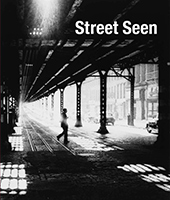 Purchase online or in the Milwaukee Art Museum Store
Purchase online or in the Milwaukee Art Museum Store
$60/$54 Members
This in-depth and generously illustrated look at six photographers prominent during and immediately following World War II refutes the common claim that photojournalism was the only significant photographic activity at the time. Street Seen uncovers what was a unique and pivotal moment in American photographic history, broadening our understanding of photography in the middle of the twentieth century, when global media was in adolescence and photography was just beginning to gain purchase in the contemporary art world.
The Second World War and its aftermath ushered in a new era of artistic expression. Abstract Expressionism, film noir, Beat poetry, and the New Journalism emerged in response to the war’s shocking realities, which were increasingly depicted in the mass media through photographs. Creative photographers broke the rules of conventional photographic technique to evoke personal experience in an increasingly anonymous world. Street Seen, a companion volume to an exhibition, highlights six photographers whose imagery encapsulates the period’s most salient aesthetic achievements. Lisette Model’s unflinching look at the cacophony of the urban environment; Louis Faurer’s empathic portraits of unglamorous eccentrics in Times Square; Ted Croner’s haunting night images; Saul Leiter’s painterly glimpses of elusive moments; William Klein’s graphic, confrontational style; and Robert Frank’s documentation of American ideals gone awry—these and other beautifully reproduced photographs communicate the emotional resonance of everyday life in postwar America.
An essay by Lisa Hostetler explores the artistic revolution that took place after the war and reveals the principles of spontaneity and subjective interpretation that guided these photographers as they sought to make sense of a new social landscape. In embracing photography as an “act of living”—an exploration of identity rather than a tool for telling a story—they create imagery with a perceivable link between form and feeling, manifesting what is termed “the psychological gesture” of mid-century American life. A timeline, brief biographies, and a bibliography are also included in this valuable compilation of the mid-century’s most influential photography.
Published by the Milwaukee Art Museum and DelMonico Books-Prestel